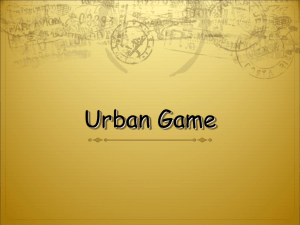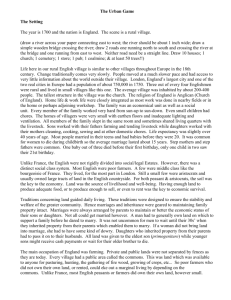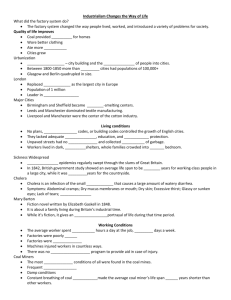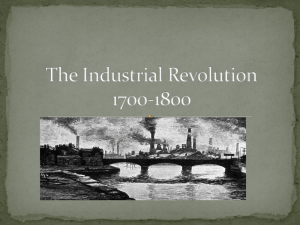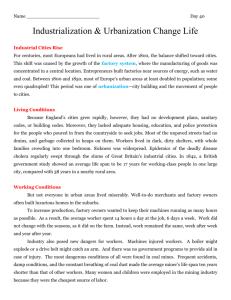Urban Geography Game
advertisement
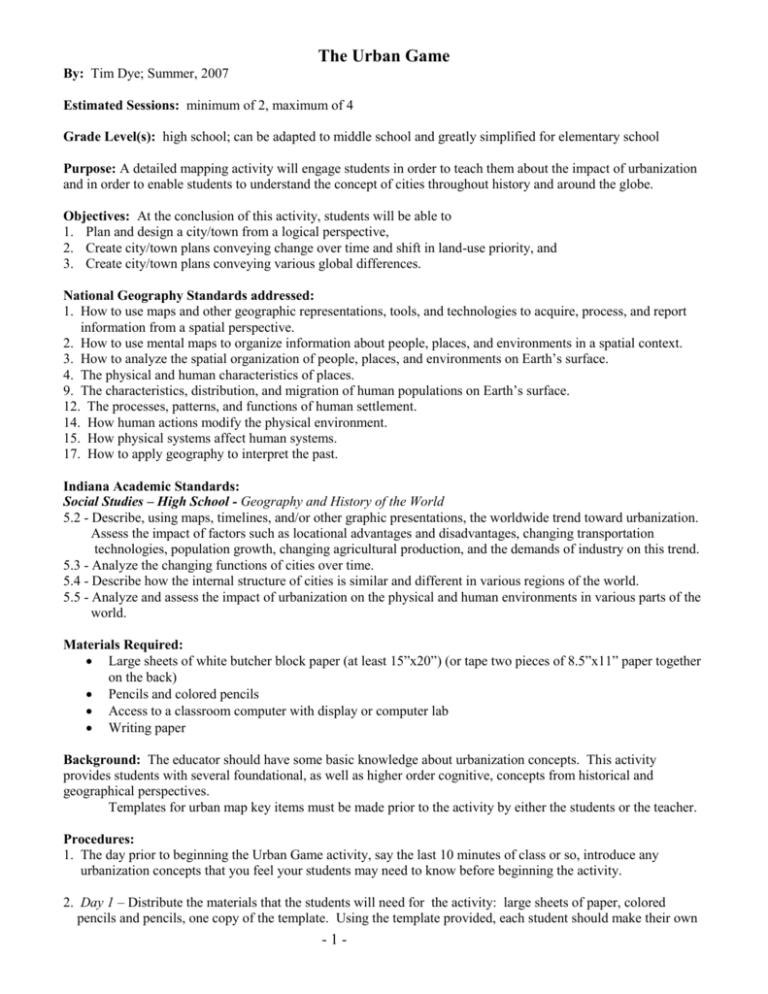
The Urban Game By: Tim Dye; Summer, 2007 Estimated Sessions: minimum of 2, maximum of 4 Grade Level(s): high school; can be adapted to middle school and greatly simplified for elementary school Purpose: A detailed mapping activity will engage students in order to teach them about the impact of urbanization and in order to enable students to understand the concept of cities throughout history and around the globe. Objectives: At the conclusion of this activity, students will be able to 1. Plan and design a city/town from a logical perspective, 2. Create city/town plans conveying change over time and shift in land-use priority, and 3. Create city/town plans conveying various global differences. National Geography Standards addressed: 1. How to use maps and other geographic representations, tools, and technologies to acquire, process, and report information from a spatial perspective. 2. How to use mental maps to organize information about people, places, and environments in a spatial context. 3. How to analyze the spatial organization of people, places, and environments on Earth’s surface. 4. The physical and human characteristics of places. 9. The characteristics, distribution, and migration of human populations on Earth’s surface. 12. The processes, patterns, and functions of human settlement. 14. How human actions modify the physical environment. 15. How physical systems affect human systems. 17. How to apply geography to interpret the past. Indiana Academic Standards: Social Studies – High School - Geography and History of the World 5.2 - Describe, using maps, timelines, and/or other graphic presentations, the worldwide trend toward urbanization. Assess the impact of factors such as locational advantages and disadvantages, changing transportation technologies, population growth, changing agricultural production, and the demands of industry on this trend. 5.3 - Analyze the changing functions of cities over time. 5.4 - Describe how the internal structure of cities is similar and different in various regions of the world. 5.5 - Analyze and assess the impact of urbanization on the physical and human environments in various parts of the world. Materials Required: Large sheets of white butcher block paper (at least 15”x20”) (or tape two pieces of 8.5”x11” paper together on the back) Pencils and colored pencils Access to a classroom computer with display or computer lab Writing paper Background: The educator should have some basic knowledge about urbanization concepts. This activity provides students with several foundational, as well as higher order cognitive, concepts from historical and geographical perspectives. Templates for urban map key items must be made prior to the activity by either the students or the teacher. Procedures: 1. The day prior to beginning the Urban Game activity, say the last 10 minutes of class or so, introduce any urbanization concepts that you feel your students may need to know before beginning the activity. 2. Day 1 – Distribute the materials that the students will need for the activity: large sheets of paper, colored pencils and pencils, one copy of the template. Using the template provided, each student should make their own -1- template. It is crucial that size for each of the “characters” in the city be the same. The students use the template to create their own homes, factories, etc . . . the template provided does not have a picture for trees, streetlamps, iron bridges, city-hall, fences. A Power Point has been developed that you can display for your students through each round. 3. Begin by having students print a title at the top of the paper (Urban Development). Students should print their names at the bottom, left-hand corner of the paper and the date at the bottom, right-hand corner. As you read each of the Rounds, your pace should increase so that by Round 15 the students will only have a short time to draw their buildings. 4. Totals are noted throughout the game in parentheses. At the conclusion, each student should have the following totals: 95 houses 22 factories 3 schools (2 private) 4 cemeteries 5 stores 1 city hall 1 Canal 2 railroads 17 Tenements 8 wealthy homes 2 jails 11 pubs 3 hospitals 2 Theaters/Museums Bridges-at least two, more if needed Roads as appropriate 1 2x2 Enclosed Commons – some students may need to destroy this (give extra-credit if they can keep it) 5. Redo the map with the totals in mind. Discuss the difference about knowing the information prior to creating the city format (this is urban planning). 6. Have the students write 10-15 sentences explaining what happened in the Urban Game. Have the students write 10-15 sentences comparing their local community to the Urban Game – great class discussion with this! 7. Discuss the changing use of the land over time – shift in priorities, enhanced technology, available transportation… 8. Have the students research cities around the globe (and the United States, and Indiana) comparing locational advantages, layout, transportation mechanisms, and origins. For example, street routes in New Albany, Indiana (along the Ohio River) versus street routes in Greenfield, Indiana (rural); San Francisco, New Orleans, Washington, D.C., Kansas City, Houston; Paris, France; Shangai, China; Taiwan; Mecca, Saudi Arabia; St. Petersburg, Russia… Suggestions: TIMEFRAME: 2 days needed just to create the city Day 1 – Set-up prior (drawing the roads, river, etc…) to Round 1 will take 20-25 minutes depending on how ontask the students are. Each Round then takes about 3-4 minutes, depending on how many items are added. Some rounds will take as many as 7-8 even 10 minutes. Should end on round 5 or 6 after a 1 day period (allowing for setup and clean-up). Day 2 – go through the final 14 – 15 rounds (skip Round 16 A if you like). This allows for a brief discussion at the end of the period. Use one of the suggested follow-ups -2- It helps to keep a running-total on the board as the students go through this. Make them do it together Round by Round as a class on Day 1. Keep them together as a class on Day 2 up until Round 15 or 16, so that too many kids don’t finish ahead of others. Some will work ahead anyway, but it’s okay. Students will become very frustrated when the start running-out of room. Be ready for this. Assessment/Evaluation: 1. Completion of the Urban Game map. 2. Completion of the planned Urban Game map (quality, clarity, accuracy). 3. Demonstrated comprehension of urban concepts in the written documents: explanation of the Urban Game happenings and comparison of the Urban Game to the local community. Adaptations/Extensions: 1. Students can further the cultural implications of urbanization by researching the layout of cemeteries – many of which have similar layouts as urban centers. 2. Create a mathematical model (equation) to depict urbanization based on population dynamics. Resources: Urban Game Power Point On-line “Patterns and Processes” Power Point by Dr. Owen Dwyer, Urban Geographer, IUPUI Topographic – Urban Map Exercise (if needed) Utilize the United States Geological Survey map symbols key (http://www.edrnet.com/reports/topomapsymbols.pdf) -3- The Urban Game MUST BE DONE IN PENCIL The year is 1700 and the nation is England. The scene is a rural village. (draw a river across your paper connecting east to west; the river should be about 1 inch wide; draw a simple wooden bridge crossing the river; draw 2 roads one running north to south and crossing the river at the bridge and one running from east to west . Neither road need be a straight line. Create an area about 4x4 inches and label it the Commons. Draw 10 houses; 1 church; 1 cemetery; 1 store; 1 pub; 1 coalmine; & at least 50 trees!!) NOTE: Roads should be no wider than ¼ of an inch and river must be no wider than 1 inch. It helps to label North, South, East, and West on the Map. Life here in our rural English village is similar to other villages throughout Europe in the 18th century. Change traditionally comes very slowly. People moved at a much slower pace and had access to very little information about the world outside their village. London, England’s largest city and one of the two real cities in Europe had a population of about 750,000 in 1750. Three out of every four Englishmen were rural and lived in small villages like this one. The average village was inhabited by about 200-400 people. The tallest structure in the village was the church. The religion of England is Anglican (Church of England). Home life & work life were closely integrated as most work was done in nearby fields or in the home or perhaps adjoining workshop. The family was an economic unit as well as a social unit. Every member of the family worked very hard from sun-up to sun-down. Even small children had chores. The homes of villagers were very small with earthen floors and inadequate lighting and ventilation. All members of the family slept in the same room and sometimes shared living quarters with the livestock. Sons worked with their fathers farming and tending livestock while daughters worked with their mothers cleaning, cooking, sewing and at other domestic chores. Life expectancy was slightly over 40 years of age. Most people married in their teens and had babies before they were 20. It was common for women to die during childbirth so the average marriage lasted about 15 years. Step mothers and step fathers were common. One baby out of three died before their first birthday, only one child in two saw their 21st birthday. Unlike France, the English were not rigidly divided into social/legal Estates. However, there was a distinct social class system. Most English were poor farmers. A few were middle class like the bourgeoisie of France. They lived, for the most part in London. Still a small few were aristocrats and usually owned large tracts of land in the English countryside. For both peasant & aristocrats, the soil was the key to the economy. Land was the source of livelihood and well-being. Having enough land to produce adequate food, or to produce enough to sell, or even to rent was the key to economic survival. Traditions concerning land guided daily living. These traditions were designed to ensure the stability and welfare of the greater community. Hence marriages and inheritance were geared to maintaining family property intact. Marriages were always arranged by parents to maintain or better the economic status of their sons or daughters. Not all could get married however. A man had to generally own land on which to support a family before he dared to marry. It was not uncommon for men to wait until their 30s’ when they inherited property from their parents which enabled them to marry. If a woman did not bring land into marriage, she had to have some kind of dowry. Daughters who inherited property from their parents had to pass it on to their husbands. All land was given to the eldest son (primogeniture) while younger sons might receive cash payments or wait for their older brother to die. The main occupation of England was farming. Private and public lands were not separated by fences as they are today. Every village had a public area called the commons. This was land which was available to anyone for pasturing, hunting, the gathering of fire wood, growing of crops, etc... So poor farmers who did not own their own land, or rented, could eke out a marginal living by depending on the commons. Unlike France, most English peasants or farmers did own their own land, however small. Villages were connected by a system of dirt roads that became almost impassable during the wet season. As a result, transportation was often slow and trade beyond the village was not easy. Most English farmers never visited -4- any place further than 25 miles from their birthplace, ever! People made their own food, clothes, furniture, tools, and homes. A few items which could not be produced could be obtained from wandering peddlers who also brought with them news. Finally for fuel, there were two sources: Firewood & coal. Nearly every English village had a coal mining operation. These mines employed a small number of village dwellers, especially in the winter. Coal pits from which coal was extracted belonged to the owner of the property where the coal mine was situated. Over the next 100 years, a revolution as significant as the Neolithic Revolution (when early man turned from hunting and gathering to agriculture) will completely change life in your village. Some historians believe this revolution (the industrial) is the most fundamental change in human history. We will experience some of these changes in the next few hours. Round 1 It is now 1745. England’s geography is unique in that no section of the country is more than 90 miles from the sea, and there are many navigable rivers that crisscross the countryside. An enterprising young capitalist (you) decides to invest money in the construction of a canal. This is not a public venture but rather a private one. The profits from your canal are astonishing! For example, one canal built in 1745, the Oxford Canal, yielded a 300% annual return for its investors for a period of more than 30 years. This new revolution in transportation reduced the price of raw materials and reduced the cost of transportation drastically. Coal could now be transported from the mines to the towns for half the price of horse-wagon transportation. Since you invested your money, thereby making a tidy profit, build yourself 1 nice home (labeled with a $) anywhere on the map you would like it to be. Don’t forget to construct the canal. It must run parallel to the river. Round 2 It is now 1750. For a variety of different reasons (soap, diet, sanitation, ect…) there is a population explosion in England, and your village. The cursed Bubonic Plague which for centuries wiped out your village has been virtually eliminated due to the disposal of sewage in the canals and then ultimately the ocean. Add 5 houses (total 15). Round 3 It is 1760. The people of your village need a bit more food and goods to meet the needs of the new inhabitants. Coincidentally, a number of other noteworthy events occur around 1760. First, a number of new mechanical inventions for farming are developed. Perhaps the greatest impact was Jethro Tull’s creation of the seed drill and the horse drawn cultivator. Also, farmers begin to experiment with new, more productive framing practices like crop-rotation, new fertilizers, & new livestock breeding techniques. Consequently farm production is significantly increased. But there is one problem. Most farmers own one tract of land. Why should they, or how could they, invest in expensive machines when their land is so small? What’s more, it’s almost impossible to buy land from anyone! At the same time, pressure is placed on Parliament by large and small landowning farmers to make more land available. Where is that land coming from? The Commons of course! A series of laws call the Enclosure Acts are passed by Parliament. This means that landowners can buy pieces of common land from the government. Fence off an area 2x2 inches to be reserved as a commons. Add 5 houses (total 20) and 1 more nice house labeled with a $ (2). Round 4 It is now 1773. A man named Richard Arkwright invents a new machine that can spin and weave cloth a hundred times faster than could be done by hand in a farm cottage ( the most common way of producing cotton cloth up to this time; the cottage industry ( putting-out system). He calls his new machine the water frame because its principle source of power was water. Let’s imagine that the first water frame was built in your village (because of the river). Since the water frame was large, a special building was needed, and thus, the first factory for producing -5- cotton cloth was built. Add 1 factory (no smoke—it is powered by water). Remember, the cotton factory must be placed on the river bank. Canal water is not swift enough to generate the power to the working parts of the water frame. Don’t add any smoke to this factory!! Add 5 houses for workers (total 25) Round 5 It is now 1774. Workers are needed to work in this new factory. Since many people (women) cannot compete with the spinning and weaving of cloth made in the factory and there are large numbers of poor families who have lost their livelihood due to the Enclosure Acts, we do have an available supply of workers. People move to your village to find work. Add 15 houses (total 40); 1 church (2) , 1 pub (2), & 1 store (2). You may draw additional roads and 1 additional bridge (2). Round 6 The profits from the first textile factory are enormous. It should be no surprise that Richard Arkwright is referred to with two titles: The first millionaire and the father of the factory. New factories are built in your community: Add 5 new factories (6). Remember these factories must be on the river bank as they need water power The early owners of these factories called themselves capitalists because they had the capital or money to purchase the raw material, the building, the water frame, to pay their workers a fixed wage, and make a profit. Add 5 houses (total 45). Round 7 It is 1780. Unemployed workers from surrounding areas flood into your community looking for work. Although wages are very low, they look attractive to starving families. Housing is in great demand and for the first time a new kind of housing is constructed called Tenements. Here dozens of families reside under one roof. Add 5 Tenements. Round 8 It is now 1781. More workers need to live, eat, shop, drink, worship. We need the social support services to go along with the demand. Add 1 store (3), 1 pub (3), 1 church (3), & 1 school for those families wealthy enough to send their children (boys) to school. Since workers in the factories work 6 days a week, the only day of rest is Sunday. People flock to your churches so make them convenient for their tired feet. Round 9 It is now 1782. Workers work long, hard hours in the factories. The average work day begins at 6:00 a.m. and ends at 9:00 p.m. There is only a 30 minute break for lunch. After work, exhausted, “stressed out” workers stop at their local pub for some relaxation. Alcohol begins to be consumed throughout England in record amounts. Add 5 more pubs (8). Destroy 5 houses (total 40), add 4 tenements (9). Round 10 It is now 1783. Workers barely eke out a marginal existence. There is never enough money to save and some workers go into debt. Few, if any, could afford to send their children to school. Still, there are a few families whose lifestyle is quite comfortable, even luxurious. Who are they? They are the large landowning farmers and factory owners. Add 2 special homes labeled with a $ (4). Handsome manor houses are built and some are lavishly furnished with art. These new rich (nouveau riche) are not part of the aristocratic class of England but they now can enjoy some of the refinements of the aristocratic rich such as food, servants, furniture, education, fine clothing, carriages, etc….Add 1 factory (7), add 15 houses for management personages (total 55) (Note: from this point on trees may be removed if you need space). Round 11 -6- The year is 1785. A man named James Watt invents a new machine called the steam engine. The steam engine replaces the water frame. First, it is far more efficient. Second, it allows factories to be built away from the river. This source of power is more mobile. Capitalists quickly replace their water frames with steam powered weaving and spinning machines. The main business in England is still textile manufacturing. Add 10 factories with smoke (17). Add smoke to all other pre-existing factories. Also, add one nicer house since people continue to get rich (5). Add 5 houses (total 60) and 1 tenement (10). Round 12 The year is 1800. A man named Henry Cort has just invented the puddling process. This process makes it possible for coal, which is fortunately in abundant supply in England, to be used as the primary fuel in the new iron industry. Consequently, your town is thrust into the “New Age of Heavy Industry”. Larger factory districts appear which manufacture iron at low prices and that can easily be transported by your canal. Add 1 new coal mine (2) and a new iron bridge to replace the old wooden one. Add 5 houses (total 65). Round 13 The year is 1815. Coal miners are busy mining coal. There is a great demand for coal right now: home-heating, fuel for the steam engines, for the production of iron. Add another coal mine (3). Although in the 1700’s coal miners were adults who worked in the winter to supplement their wages, in the 1800’s they are typically children between the ages of 8 and 14. The work is dangerous and unhealthy. Children become victims of black lung, explosions, & accidents. Their growth is stunted as they spend their 14 hour day stooped over. They are malnourished and unable to exercise or eat properly. Casualty rates go up. Draw 1 cemetery (2). Round 14 It is 1820. The existing canals and dirt roads cannot accommodate the heavy industrial traffic. New experiments with transportation using the power of a steam engine are tried. The most successful appears to be a steam engine that pulls a series of wagons or cars on an iron track. The first railroad is tested and proves to be quite effective. Add 1 major railroad line connecting all your factories to your coal mines. This is one continuous track which must connect all factories and mines (you may build additional railroad bridges only as needed). Add 5 houses (total 70) for railroad builders. Round 15 It is 1827. This new “revolution” in transportation draws thousands of people to your community. Soon there becomes a surplus of workers. Capitalists who wish to ensure their profits decide to hire women and children over men because they can perform the same factory labor at one-half to one-quarter the price. More and more children leave their homes to work. Depressed, ashamed, and angry about their wives and children toiling in factories, many men turn to crime and the social life of the pub. For the first time in England’s history, alcoholism appears in epidemic proportions. Family life that existed for hundreds of years in England is disrupted. Family members seldom eat together or see each other. Add 1 jail (1) & 2 pubs (10) and 2 tenements (12). Round 16 (Skip if you like) It is 1835. Using steam engines, iron and soon steel, British manufacturers introduced power-driven machinery in many industries. The production of shoes, clothing, ammunition, and furniture became mechanized, as did printing and paper-making. People used machines to cut and finish lumber, to process foods, and to make other machines. Some new inventions and innovation processes had important by-products. These by-products often developed into separate industries. For example, iron smelters used coke, a by-product of coal, to improve the smelting process. Then someone discovered that the gases that coal released during the coke-making process could be burned to give light. During the 1830’s London and other large towns became the first communities to pipe in gas to burn in street lights. Soon all around England hundreds of towns used gas to light streets and homes. Add 20 street lamps. (these are streetlamps and must be located along streets) -7- Round 16 It is 1838. Let’s look at the working conditions in the factories. The two predominant factories are textile and iron (steel). Working conditions in either of these two were appalling. Many workers contracted the deadly factory fever or white lung disease. It was probably a variety of lung ailments: cancer, tuberculosis, emphysema, etc… Other workers were injured on the job in factory accidents. There were no protective railings around the huge moving mechanical parts of machinery. Children, weakened from lack of proper sleep or diet, stumbled into machinery and were mutilated. Women with long hair that became undone often found themselves caught in moving machinery. Regardless, if you were unable to work, you were fired. There was no health insurance. There was always a daily line of unemployed workers waiting to fill vacant jobs. Add 2 hospitals and 1 more cemetery (3). Round 17 It is 1840. There is a need for quicker transportation. Coal, iron, finished products, & raw materials must all be transported from one area of England to another. In Ireland in the late 1830’s a devastating potato famine drove hundreds of thousands of Irish to England. Here was the cheapest of labor possible to build more railroads. Add 1 more railroad line (2) passing east to west through your town. Add 5 houses (total 75) and 1 tenement (13) for the new railroad workers. Round 18 It is 1842. There are some advantages to urban dwellers. City life is very different from the country life. For the small but growing middle classes, a whole new cultural life is available. Museums, theater, opera, restaurants, plays, & concerts are made available. Whereas before only the aristocrats could afford the arts, but now the middle class enjoys the fine life of culture and good living. Add 1 theater and 1 museum (use the same symbol for each). Add 2 private schools (3) for upper class students (mark these schools with the letter “P”. Add 1 nice house labeled with a $ (6). Round 19 It is 1845. There are no pollution controls so the air in your community looks dark. Windows, walls even trees are covered with layers of soot and coke. The river that once flowed through your quiet village for hundreds of years is now unfit for drinking, bathing, or laundry. A new disease begins to take the lives of people. Malignant tumors grow in peoples’ bodies and the term cancer is first used in the medical profession. The average life expectancy for the poor classes is now 30 years of age. Your city is overcrowded and shrouded in factory smoke. The noises, the loss of privacy, & the loss of the family unit shatters the peace of the old ways. Suicide rates double, then triple. Add 1 cemetery (4), 1 jail (2), 1 hospital (3) to accommodate the victims of urban life. Round 20 It is 1850. By this year several million acres of good English land has been enclosed and sold to private parties who own large estates. Despite the misery this creates for England’s landless poor, the economy benefits for the rich are obvious. These farmers purchase the newest power-driven machinery and can easily feed the working class of England (including the Irish). The small landowning farmer is crushed by the enclosed commons. They cannot afford the machinery and therefore cannot compete and grow food profitably. Thousands of these folk leave their villages (where their ancestors had lived for hundreds of years) and move to towns and cities looking for work to feed their families. Some refused to leave but took jobs working for the large landowning farmers. By the thousands, they moved to the bleak, uninviting towns of the north and the new cotton mills. Add 20 houses (total 95), 5 tenements (17), 2 stores (5), 1 church (4), 5 factories (22), and 1 pub (11), and 2 more nice houses (8) and one special house to serve as city hall. -8- Design a Village, c. 1850 Using what you have learned about the evolution of a town, from a site along a fast flowing river to a bustling economic center, design a town “from scratch”. Your town must include the following structures and spaces. Use a second sheet of paper to do this and tape the two together for comparison after completion, but the town should include the flowing structures: 1 river 3 bridges 80 modest houses 1 city hall 15 splendid houses 1 museum 10 stores 2 secondary school (public) 3 primary schools 20 tenements 1 bank 1 hospital 5 pubs 1 theater 5 restaurants 3 churches 1 courthouse/jail 2 cemeteries 10 factories (various sizes) 2 parks 2 railroad line, 2 stations 1 library 8 streets with one intersection 1 feed mill (where farmers buy grain) 3 coalmines Upon completion, some groups will be called upon to explain the rationale of their designs. -9- Tree City Hall - 10 -


